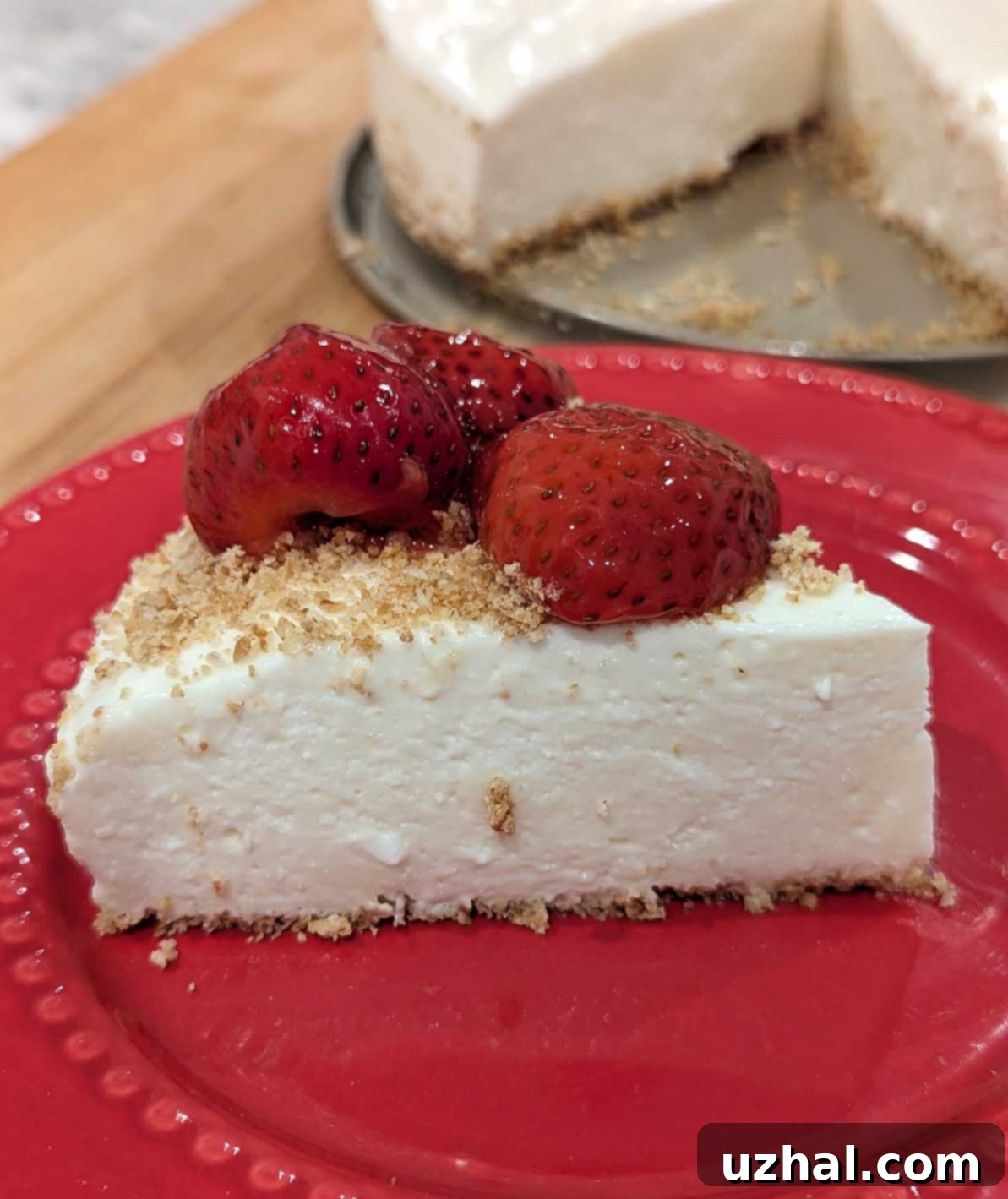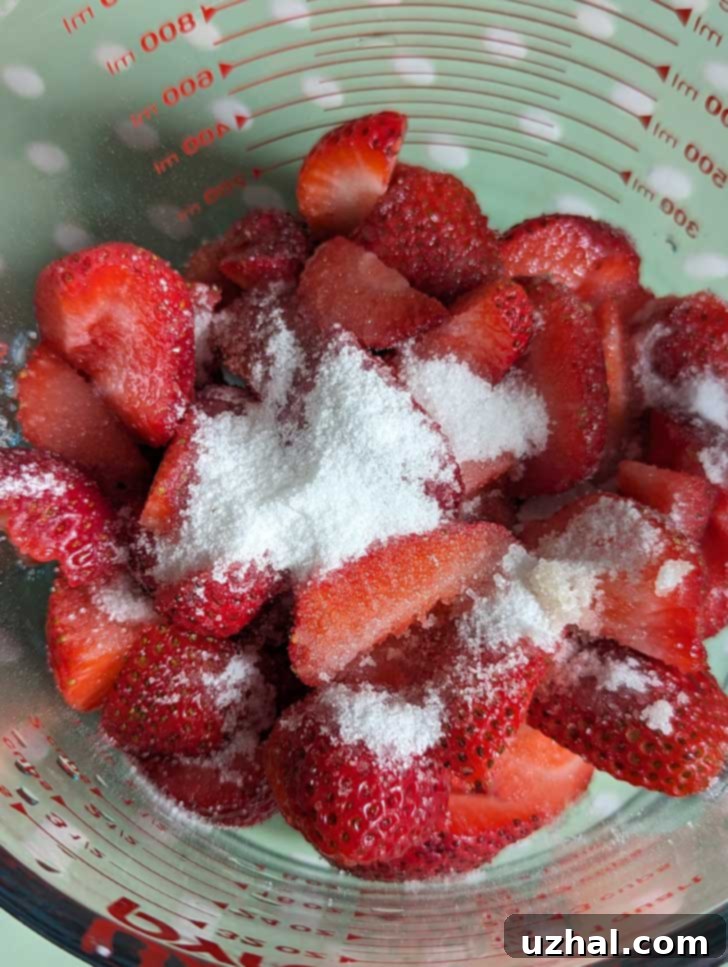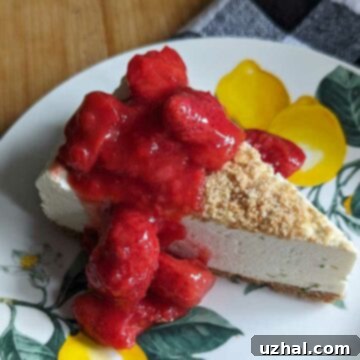Easy Homemade Strawberry Sauce & Topping: A Versatile Recipe for Fresh and Frozen Berries
There’s nothing quite like a luscious, homemade strawberry sauce to elevate a simple dessert or breakfast. Whether you’re topping an elegant ice cream cake, drizzling it over pancakes, or enhancing a creamy cheesecake, a well-made strawberry sauce is an absolute game-changer. For a long time, my go-to recipe for this essential condiment was tucked away within other complex dessert recipes, much like my favorite fudge sauce. Now, this incredibly versatile and easy-to-make strawberry sauce finally gets its own spotlight. This recipe stands out because it offers clear instructions for both fresh and frozen strawberries, making it a year-round staple, and best of all, neither version requires a food processor, keeping your kitchen cleanup minimal.
The beauty of crafting your own strawberry sauce lies in the control you have over its flavor and texture. Unlike many store-bought varieties that can be overly sweet or contain artificial ingredients, this homemade version lets the natural brightness of strawberries shine. It’s simple, pure, and utterly delicious, making it perfect for those who appreciate wholesome, flavorful additions to their meals. From vibrant fresh berries of summer to convenient frozen options during colder months, this recipe ensures you can always whip up a batch of this delightful topping. Its straightforward process and minimal ingredients mean you’ll be enjoying spoonfuls of strawberry goodness in no time.

Crafting the Perfect Fresh Strawberry Topping
Using fresh strawberries for your topping results in a vibrant, intensely flavored sauce that truly captures the essence of summer. The topping shown in the photo above was prepared with 2 cups of ripe fresh strawberries, complemented by just 2 tablespoons of granulated sugar and 1 ½ teaspoons of cornstarch. The key to unlocking the deepest flavor and perfect texture with fresh berries is a technique called maceration. This involves tossing the sliced strawberries with sugar and allowing them to rest for several hours. During this time, the sugar draws out the natural juices from the strawberries, creating a rich, flavorful liquid that forms the base of your sauce.
Maceration is a crucial step for a few reasons. Firstly, it enhances the strawberry flavor by concentrating the sugars and acids. Secondly, it helps prevent the berries from becoming overly mushy during the cooking process, allowing them to retain some of their structural integrity while still releasing their delicious juices. The exact time required for maceration can vary; it largely depends on the juiciness and ripeness of your specific strawberries. Generally, you’ll need to plan ahead, as this step can take anywhere from 4 hours up to overnight in the refrigerator. You’ll know they’re ready when a good amount of liquid has collected at the bottom of the bowl, typically between ⅓ and ½ cup. If you find yourself with less than ½ cup, simply add a splash of water to reach the desired volume before proceeding with the recipe.
When selecting fresh strawberries, look for those that are bright red, plump, and fragrant. Avoid berries with soft spots or mold. Riper berries will yield more juice and a sweeter, more intense flavor, which can reduce the amount of added sugar needed. This fresh strawberry topping is ideal for special occasions where presentation is key, such as on a delicate cheesecake, strawberry shortcake, or as an elegant accompaniment to panna cotta. The distinct pieces of fruit combined with the glossy, thickened sauce create an appealing visual and textural contrast.

Effortless Frozen Strawberry Sauce or Topping
While fresh strawberries offer a seasonal delight, frozen strawberries provide unparalleled convenience and make this delicious sauce accessible year-round. They are particularly excellent for creating a rich, flavorful sauce or topping, though their softer texture after thawing sometimes means they might not appear as aesthetically pristine as their fresh counterparts. For example, when I prepared a batch using thawed frozen strawberries for a lime cheesecake, I wasn’t gentle enough, and the resulting sauce looked a bit rougher around the edges, as pictured. While it tasted absolutely divine, it served as a valuable reminder to handle frozen, thawed strawberries with care to maintain as much of their shape as possible.
The primary advantage of using frozen strawberries is their readiness and availability. You can buy them in bulk and have them on hand whenever a craving for strawberry sauce strikes. Thawing the fruit is the first step, and it can be done either overnight in the refrigerator for a gradual thaw or more quickly in the microwave on a low setting. Once thawed, it’s crucial to drain the juice from the fruit. A pound of frozen strawberries typically yields between ⅓ and ½ cup of liquid. If you find yourself with less than ½ cup of juice, don’t worry – simply add a little water to reach the ½ cup mark, ensuring you have enough liquid to properly dissolve the cornstarch and thicken the sauce to perfection.
When preparing the sauce, after you’ve combined the drained liquid with sugar and cornstarch and brought it to a boil, gently fold in the thawed strawberries. Over-stirring or excessive boiling at this stage can break down the already softened fruit, leading to a more jam-like consistency. If a perfectly uniform, smooth sauce is what you desire, you can gently mash some of the berries or even briefly use an immersion blender for a few pulses. However, for a topping with delightful chunks of fruit, a gentle touch is all that’s needed. This frozen strawberry sauce is fantastic over ice cream, layered in parfaits, swirled into yogurt, or as a vibrant addition to waffles and pancakes, making everyday meals feel a bit more special.
Tips for Perfecting Your Strawberry Sauce
Whether you opt for fresh or frozen berries, a few techniques can help ensure your strawberry sauce turns out perfectly every time.
- Cornstarch slurry: Always dissolve cornstarch in a cold liquid (like the strawberry juice or a splash of water) before adding it to a hot mixture. This prevents lumps and ensures a smooth, glossy sauce.
- Adjusting sweetness: The sweetness of strawberries varies greatly. Taste your berries before adding sugar and adjust accordingly. You might need slightly more or less sugar than the recipe calls for.
- Flavor enhancements: A squeeze of lemon juice not only brightens the strawberry flavor but also helps to balance the sweetness. A tiny splash of almond extract or vanilla extract can add a wonderful depth, while orange or lime juice can introduce a lovely citrusy zing. For an adult twist, a tablespoon of Grand Marnier or a fruit liqueur can be a delightful addition.
- Preventing scorching: Stir the sauce frequently while it’s on the heat, especially once it starts to thicken, to prevent it from sticking to the bottom of the saucepan and scorching.
- Achieving desired thickness: If your sauce is too thin, you can create a separate cornstarch slurry (1 teaspoon cornstarch mixed with 1 tablespoon cold water) and whisk it into the simmering sauce, cooking for another minute until it thickens. If it’s too thick, a tablespoon or two of water or orange juice can thin it out.
- Storage: Homemade strawberry sauce can be stored in an airtight container in the refrigerator for up to a week. For longer storage, it freezes beautifully for up to 3 months. Thaw in the refrigerator before using.
Versatile Uses Beyond Desserts
While strawberry sauce is a classic dessert accompaniment, its uses extend far beyond. Unleash your culinary creativity with these ideas:
- Breakfast Bliss: Drizzle generously over pancakes, waffles, French toast, oatmeal, or Greek yogurt for a delightful morning treat.
- Dessert Dynamo: Beyond ice cream cakes, it’s incredible on vanilla ice cream, chocolate lava cakes, pavlova, rice pudding, or as a filling for crepes and tarts.
- Beverage Booster: Stir a spoonful into sparkling water or lemonade for a refreshing drink, or blend it into smoothies and milkshakes. It can also be a fantastic base for strawberry margaritas or mocktails.
- Savory Pairings: Don’t limit it to sweet dishes! A slightly less sweet strawberry sauce can pair surprisingly well with savory items. Consider serving it alongside roasted duck, pork loin, or even on a cheese board with creamy cheeses like brie or goat cheese.
- Baking Brilliance: Swirl it into muffin batter, use it as a layer in a trifle, or as a glaze for cakes and pastries.
Making your own strawberry sauce is not only rewarding but also incredibly simple. It’s a wonderful way to enjoy the fresh, bright flavor of strawberries in countless ways, making it a staple in any kitchen. Whether you have an abundance of fresh summer berries or a bag of frozen ones in the freezer, this recipe ensures a delicious outcome every time. So go ahead, whip up a batch, and let your culinary imagination run wild!
- Strawberries & Cream Cake
- Glazed Strawberry Pie with Cream Cheese
- Chocolate Covered Strawberry Bars
- Layered Strawberry Dessert
- Strawberry Cake with Pudding Frosting
Recipe

Easy Strawberry Sauce and Topping Recipe
Anna
Pin Recipe
Ingredients
Frozen Strawberry Sauce or Topping
- 1 pound frozen strawberries
- 2 tablespoons granulated sugar (25 grams)
- 2 teaspoons cornstarch (6 grams)
- Optional: Splash of lemon juice, almond extract, orange juice, lime juice, etc.
Fresh Strawberry Sauce
- 2 cups strawberries, sliced (170 grams)
- 2 tablespoons granulated sugar
- 1 ½ teaspoons cornstarch
- Optional: Splash of lemon juice, almond extract, orange juice, lime juice, etc.
Instructions
Frozen Strawberry Sauce Recipe
-
Thaw the fruit overnight in the refrigerator or in the microwave using a low setting. Drain the juice from the fruit. In my experience, a pound of frozen strawberries should give you between ⅓ and ½ cup of liquid. If you only get ⅓ cup, add a little extra water to make ½ cup.
-
In a medium size (I use a 3 quart) saucepan, combine the sugar and cornstarch, then stir in the cold strawberry liquid. Stir to dissolve cornstarch completely.
-
Place saucepan over medium heat and whisk or stir continuously until the mixture boils, thickens, and becomes somewhat translucent. Gently stir in the thawed strawberries.
-
Remove from heat immediately. Add any optional ingredients you wish (like lemon juice or extract) and let the sauce cool completely before serving.
Fresh Strawberry Sauce Recipe
-
Toss the sliced fresh strawberries with granulated sugar in a bowl and let sit (macerate) for at least 4 hours, or until a sufficient amount of liquid has collected, typically between ⅓ and ½ cup. If needed, add enough water to the liquid to make ½ cup.
-
Combine the cold, macerated strawberry juice with cornstarch in a saucepan and stir until the cornstarch is fully dissolved. Turn the heat to medium and cook, stirring frequently, until the mixture begins to thicken and clarify. Gently stir in the macerated strawberries.
-
Remove from heat. Incorporate any optional ingredients desired, such as lemon juice or almond extract, and allow the sauce to cool before use.
